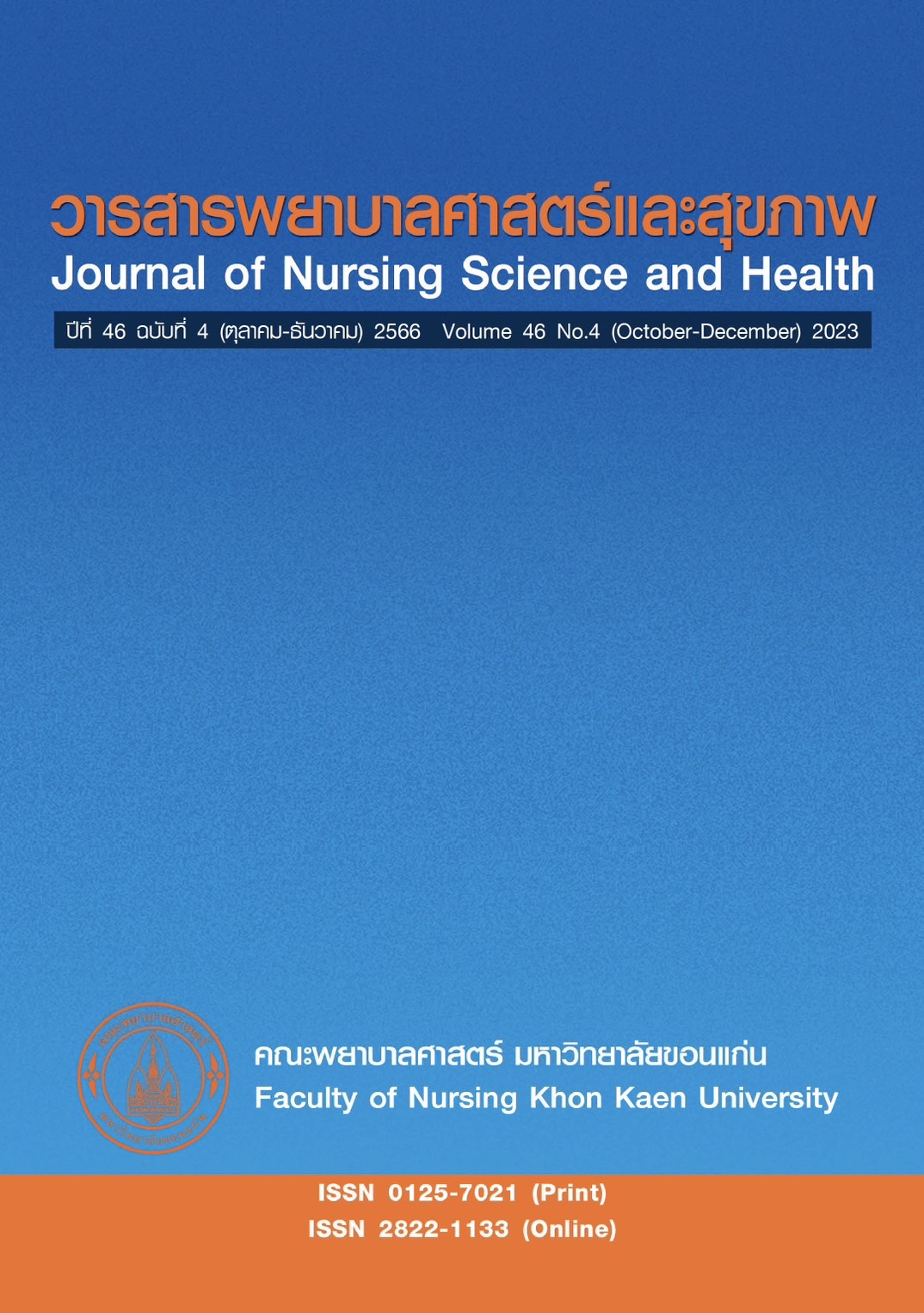ผลของโปรแกรมการจัดการภาวะโภชนาการโดยใช้แนวคิด ชุดการจัดการโภชนาการ (Nutrition bundle) ต่อผลลัพธ์ทางด้านโภชนาการในผู้ป่วยที่มีภาวะติดเชื้อในกระแสเลือด : การศึกษานำร่อง
คำสำคัญ:
การจัดการภาวะโภชนาการ, ชุดการจัดการโภชนาการ, ผู้ป่วยติดเชื้อในกระแสเลือดบทคัดย่อ
การศึกษานำร่องครั้งนี้เป็นการวิจัยแบบกึ่งทดลอง มีวัตถุประสงค์เพื่อศึกษาผลของโปรแกรมการจัดการภาวะโภชนาการโดยใช้แนวคิด ชุดการจัดการโภชนาการ (Nutrition bundle) ต่อผลลัพธ์ทางด้านโภชนาการในผู้ป่วยติดเชื้อในกระแสเลือดที่เข้ารับการรักษาในหอผู้ป่วยหนักอายุรกรรม 2 โรงพยาบาลขอนแก่น ระหว่างเดือนสิงหาคม-กันยายน พ.ศ. 2565 จำนวน 10 ราย เครื่องมือที่ใช้ในการวิจัยคือโปรแกรมการจัดการภาวะโภชนาการในผู้ป่วยติดเชื้อ sepsis และแบบประเมินผลลัพธ์ทางโภชนาการ วัดผลลัพธ์สองครั้งคือก่อนได้รับโปรแกรมและในวันที่ 7 หลังจากเสร็จสิ้นโปรแกรม วิเคราะห์ข้อมูลโดยใช้สถิติ paired t-test
ผลการศึกษาพบว่า 1) ค่าเฉลี่ยพลังงานที่ได้รับของกลุ่มตัวอย่างระหว่างก่อนและหลังได้รับโปรแกรมแตกต่างกันอย่างมีนัยสำคัญทางสถิติ (t=-6.24, p-value=.001) 2) ค่าเฉลี่ยระดับอัลบูมินในเลือดของกลุ่มตัวอย่างระหว่างก่อนและหลังได้รับโปรแกรมแตกต่างกันอย่างมีนัยสำคัญทางสถิติ (t=-2.47, p-value=.035) และ 3) ค่าเฉลี่ยโปรตีนที่ได้รับของกลุ่มตัวอย่างระหว่างก่อนและหลังได้รับโปรแกรมแตกต่างกันอย่างมีนัยสำคัญทางสถิติ (t=-6.28, p-value=.001)
สรุปได้ว่า โปรแกรมการจัดการภาวะโภชนาการโดยใช้แนวคิด ชุดการจัดการโภชนาการ Nutrition bundle ในผู้ป่วยที่มีภาวะติดเชื้อในกระแสเลือดมีส่วนทำให้ผลลัพธ์ทางด้านโภชนาการของผู้ป่วยดีขึ้น ได้แก่ พลังงานที่ได้รับ ระดับอัลบูมินในเลือด และโปรตีนที่ได้รับ ผู้วิจัยได้ให้ข้อเสนอแนะสำหรับพยาบาลในการนำโปรแกรมไปใช้และการวิจัยในอนาคต
เอกสารอ้างอิง
Evans L, Rhodes A, Alhazzani W, Antonelli M, Coopersmith CM, French C, et al. Surviving sepsis campaign: International guidelines for management of sepsis and septic shock 2021. Intensive Care Med 2021;47:1181-247.
Rhodes A, Evans L, Alhazzani W, Levy M, Antonelli M, Ferrer R, et al. Surviving sepsis campaign international guidelines for management of sepsis and septic shock 2016. Intensive Care Med 2017;43:304-77.
Benyapad P. Kongsaman P. Nutritional support in critically ill patients: The challenge of nurses role. Vajira Medical Journal: Journal of Urban Medicine 2019;63 (3):219-30. (in Thai)
Hagve M, Gjessing P, Y Marius Lars, I Øivind. Nutritional support for critically ill patients in the intensive care unit. Tidsskr Nor Laegeforen 2020;30:140(2). doi: 10.4045/ tidsskr.19.0426. PMID: 32026867.
Wischmeyer P. Nutrition therapy in sepsis. Crit Care Clin 2018;34:107-25.
Kalaiselvan MS, Renuka MK, Arunkumar AS. Use of nutrition risk in critically ill (NUTRIC) score to assess nutritional risk in mechanically ventilated patients: A prospective observational study. Indian Journal of Critical Care Medicine 2017;21(5):253-6.
Wischmeyer P, Are we creating survivors or victims in critical care? Delivering targeted nutrition to improve outcomes. CurrOpin Crit Care 2016;22(4):279-84.
Ata ur-Rehman H M, Ishtiaq W, Yousaf M, Bano S, Mujahid AM, Akhtar A. Modified nutrition risk in criticallyill (mNUTRIC) score to assess nutritional risk in mechanically ventilated patients: A prospective observational study from the Pakistani population. Cureus 2018;10(12). doi: 10.7759/cureus.3786
Vanblarcom A, McCoy MA. New nutrition guidelines: Promoting enteral nutrition via a Nutrition bundle. Critical Care Nurse 2018;38(3):46-52.
Warodomwichit D, Yamwong P, Hongsprabhas P, Chittawattanarat K, Angkatavanich J, Pispraser V, et al. Thai clinical practice recommendations for nutritional management in adult hospitalized patients 2017 part 1: Enteral nutrition (recommendation 1-4). Thai JPEN 2019;1:10-38. (in Thai)
Mcclave S, Taylor B, Martidale R, Warren M, Johnson D, Braunschewig C, et al. Guideline for the provision and assessment of nutritionsupporttherapyintheadultcriticallyill patient: Society of critical care medicine (SCCM) and American society for parenteral and enteral nutrition (ASPEN). Journal of Parenteral and Enteral Nutrition 2016;40(2):159-211.
Singer P, Reintam Blaser A, Berger M, Alhazzani W, Calder P, Casaer M, et al. ESPEN guideline on clinical nutrition in the intensive care unit. Clinical Nutrition 2019;38(1):48-79.
Preiser JC, Arabi YM, Berger MM, Casaer M, McClave S, Montejo González JC, et al. A guide to enteral nutrition in intensive careunits: 10expert tips for the daily practice. Critical Care 2021;25(1):1-13.
Kulnitichai W. Nursing care for continuous monitoring of malnutrition in critical patients. Thai Journal of Cardio-Thoracic Nursing 2020;30(1):2-16. (in Thai)
Patel J, Rice T, Daren K. Heyland, Safety and outcomes of early enteral nutrition in circulatory shock. Journal of Parenteral and Enteral Nutrition 2020;44(5):779-84. doi: 10.1002/ jpen.1793
De Waele E, Malbrain MLMG, Spapen H. Nutrition in sepsis: Abench-to-bedside review. Nutrients 2020;12(2):395. doi:10.3390/nu12020395
Wikjord K, Dahl V, Søvik S. Effects on nutritional care practice after implementation of a flowchart-based nutrition support protocol in an intensive care unit. WILEY Nursing Open 2017;4(4):282-91. doi:10.1002/nop2.99
Insee A, Saensom D. Effects of a nutritional management clinical practice guideline in critically ill trauma patients. The Journal of Baromarajonani College of Nursing, Nakhonratchasima 2017; (25)(2):118-37. (in Thai)
Traiyawong S, Saensom D, Methakanjanasak N. Effects of clinical practice guideline for enteral feeding among critically ill medical patients in Mukdahan Hospital. Journal of Sakon Nakhon Hospital 2017;21(3):22-33. (in Thai)
Yin M, Si L, Qin W, Li C, Zhang J, Yang H, et al. Predictive value of serum albumin level for the prognosis of severe sepsis without exogenous human albumin administration: A prospective cohort study. Journal of Intensive Care Medicine 2016;33(12):687-94. doi: 10.1177/0885066616685300
Eckart A, Struja T, Kutz A, Baumgartner A, Baumgartner T, Zurfluh S. Relationship of nutritional status, inflammation, and serum albumin levels during acute illness: A prospective study. The American Journal of Medicine 2020;133(6):713-22. doi:10.1016/j.amjmed.2019.10.031
Ichimaru S, Amagai T. Intermittent and bolus methods of feeding in critical care. Diet Nutr Crit Care 2015:2:533-48
Ministry of Public Health.Ministry of Public Health. Mortality rate for patients with severe bloodstream infections community-acquired (Internet). Nonthaburi: Ministry of Public Health: 2018 [cited 2023 Jun 8]. Available from: http://healthkpi.moph.go.th/kpi2/kpi-list/view/?id=1926
Teeranud A, Koontalay A. Nursing care to promote nutrition in critically ill patients: Using FAST HUG concept. Journal of Nursing Science & Health 2017;40(3):126-37. (in Thai)
Wikjord K, Dahl V, Søvik S. Effects on nutritional care practice after implementation of a flowchart-based nutrition support protocol in an intensive care unit. Nursing Open 2017;4(4): 282-91.
Allingstrup M, Kondrup J, Wiis J, Claudius C, Pedersen U, Hein Rasmussen R, et al. Early goal-directed nutrition versus standard of care in adult intensive care patients: The single-center, randomized, outcome assessor-blinded EATICU trial. Intensive care Med 2017;43(11):1637-44. doi: 10.1007/s00134-017- 48803
Lee ZY, Barakatun-Nisak Y, Noor Airini I, Heyland DK. Enhanced protein-energy provision via the enteral route in critically ill patients (PEP uP Protocol): A review of evidence. Nutrition in Clinical Practice 2015;31(1):68-79. doi:10.1177/0884533615601638
ดาวน์โหลด
เผยแพร่แล้ว
รูปแบบการอ้างอิง
ฉบับ
ประเภทบทความ
สัญญาอนุญาต
ลิขสิทธิ์ (c) 2023 วารสารพยาบาลศาสตร์และสุขภาพ

อนุญาตภายใต้เงื่อนไข Creative Commons Attribution-NonCommercial-NoDerivatives 4.0 International License.
วารสารพยาบาลศาสตร์และสุขภาพเป็นเจ้าของลิขสิทธิ์ในการเผยแพร่ผลงานที่ตีพิมพ์ห้ามผู้ใดนำบทความที่ได้รับการตีพิมพ์ในวารสารพยาบาลศาสตร์และสุขภาพไปเผยแพร่ในลักษณะต่าง ๆ ดังนี้ การนำบทความไปเผยแพร่ออนไลน์ การถ่ายเอกสารบทความเพื่อกิจกรรมที่ไม่ใช่การเรียนการสอน การส่งบทความไปตีพิมพ์เผยแพร่ที่อื่น ยกเว้นเสียแต่ได้รับอนุญาตจากวารสารพยาบาลศาสตร์และสุขภาพ



